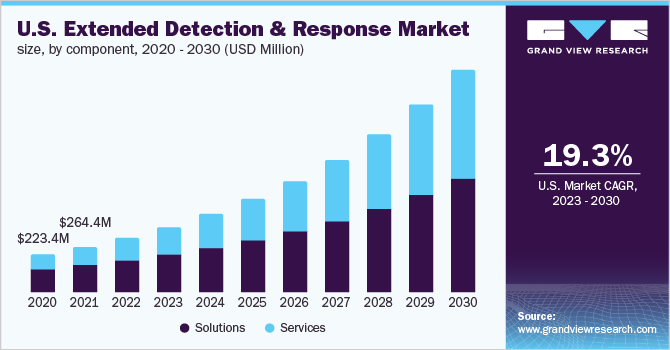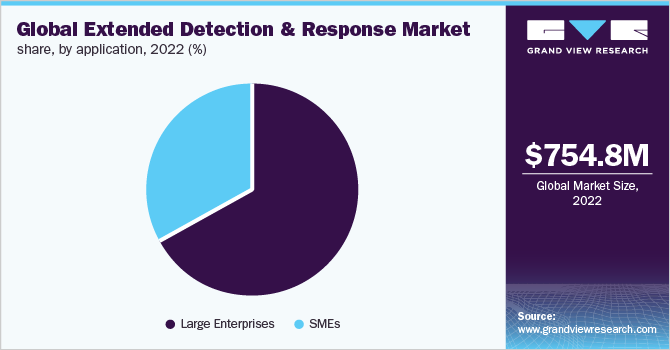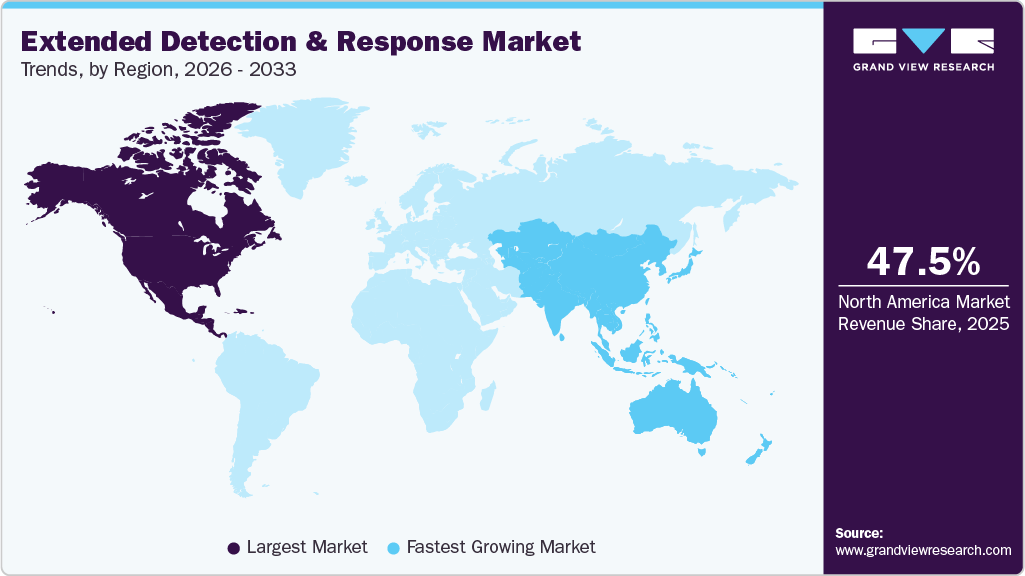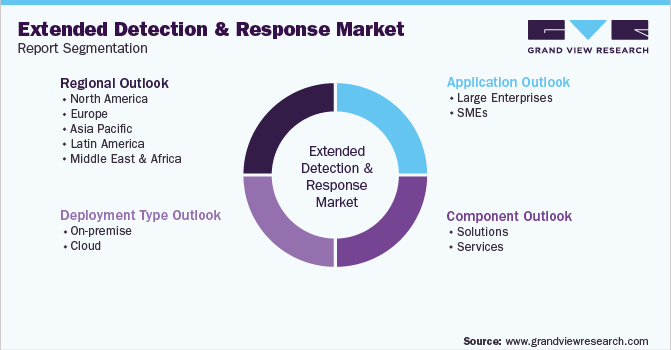
Extended Detection And Response Market Size, Share & Trends Analysis Report By Component (Solutions, Services), By Deployment Type, By Application (Large Enterprises, SMEs), By Region, And Segment Forecasts, 2023 - 2030
- Report ID: GVR-4-68038-304-1
- Number of Report Pages: 110
- Format: PDF
- Historical Range: 2018 - 2021
- Forecast Period: 2023 - 2030
- Industry: Technology
Report Overview
The global extended detection and response market size was valued at USD 754.8 million in 2022 and is expected to grow at a compound annual growth rate (CAGR) of 20.7% from 2023 to 2030. Extended detection and response (XDR) is a new security technology, developed to respond to the need for sophisticated and comprehensive detection and response. Ongoing developments in technologies such as the cloud and the Internet of Things (IoT) have raised the risk of cyber threats, creating challenges in securing critical data. As a result, businesses are spending on several security solutions to strengthen their security and reduce redundant attacks.

The increased integration of several software solutions with existing systems and heightened complexities in managing multiple alerts with limited context about the increasing number of security threats cause security teams to lose visibility, hampering business operations. The scenario has led to the development of XDR technology, which uses machine learning techniques and dynamic analytics to deliver extended visibility, response, and analysis across clouds, networks, and endpoints.
Over the years, the enhanced visibility and awareness of security threats offered by XDR solutions have led to their increased popularity in the U.S. By integrating XDR solutions, enterprise security analysts can eliminate and target cyber threats based on the severity at which they can impact the organization’s IT infrastructure. The rising popularity of XDR solutions has encouraged several cybersecurity vendors in the U.S. to introduce advanced EDR and XDR solutions. For instance, in February 2020, SentinelOne, a U.S.-based cybersecurity solution provider, launched an AI-powered XDR solution that offers advanced threat detection and complete visibility across every end-point device, physical or virtual, on-premise, or on the cloud.
The rising need for real-time monitoring and investigation of advanced threats is compelling organizations to adopt security solutions that extend the capabilities of threat detection from endpoints to multiple security control points such as emails, servers, the cloud, and networks. This is driving the adoption of XDR tools that allow behavioral and telemetry analysis across several security layers. It allows security analysts to visualize several threats. Additionally, the use of XDR tools reduces downtime on critical servers by offering tailored incident responses. These benefits are expected to drive extended detection and response industry growth over the forecast period.
Increasingly complex regulatory compliance requirements, the shortage of technical security staff, rapid migration to cloud computing, and the unrelenting evolution of threats continue to increase security challenges for businesses. The COVID-19 pandemic was a major challenge for most security businesses across the world in 2020. The pandemic has refocused the attention of security staff on operational tools and cloud-delivered security tools that do not require a Local Area Network (LAN) connection to function, and the need to migrate to cloud data centers and software as a service (SaaS) applications. This has encouraged businesses to adopt XDR solutions to access policies and track threats across the cloud and business networks remotely.
Digitization and automation in security monitoring and threat detection gained prominence as organizations were pushed to adopt the remote working model during COVID-19. With real-time security and workflow management capabilities, XDR solutions help security analysts significantly reduce the time spent on repetitive training, tasks, and providing support. In addition to the common management and workflow management activities, XDR solutions also provided a large stream of alerts into smaller incidents with their severity level. These factors have contributed to the extended detection and response market growth during COVID-19.
Component Insights
By component, the extended detection and response industry is segmented into solutions and services. The solutions segment dominated the market in 2022 and accounted for nearly 58% of the global revenue share. The need for a unified solution that can provide a holistic view of cyber threats across several control points, ranging from end-points to networks and servers, has helped increase the adoption of XDR solutions. Moreover, the need to reduce the complexities associated with managing several security solutions and the alerts provided by such solutions have also contributed to the growth of the segment.
The services segment is expected to register the highest CAGR from 2023 to 2030. The evolving risks of cyber threats across security perimeters of organizations are driving the need for managed services. Demand for managed XDR vendors also continues to rise, to assess the IT infrastructures of organizations in real-time and also to detect and mitigate advanced threats. Furthermore, the rising demand for implementation and training services is driving the services segment.
Deployment Type Insights
Based on the deployment type, the XDR market is segmented into cloud-based and on-premise sub-segments. The on-premise sub-segment accounted for around 54% of the global revenue share in 2022. Enterprises with mandatory IT infrastructure prefer the installation of extended detection and response solutions on their own premises as they possess entire ownership of the upgrades and solutions. Many large enterprises and organizations which deal with critical business information select on-premise XDR solutions as they provide an optimum level of data security and physical access controls.
The cloud-based segment has gained popularity owing to its cost benefits and flexibility. Additionally, the major market players are concentrating on launching cloud-based advanced threat management solutions to capitalize on the rising cloud solutions market. For instance, in October 2020, McAfee, LLC launched MVISION XDR, a proactive, data-aware, and open XDR cloud-based platform. Cloud-based extended detection and response solutions eliminate the need for the consumer to manage, upgrade, and buy the software.
Application Insights
The large enterprise segment led the market in 2022 and accounted for more than 60% of the global revenue. Large organizations face a bigger risk from cyber threats, owing to the large number of employees processing sensitive business information and data on their workstations. Furthermore, the increasing trend of Bring Your Own Device (BYOD) among technology companies is intensifying the threat of cyber-attacks, driving the demand for XDR solutions.

The demand for XDR solutions and services across small and medium enterprises (SMEs) is expected to rise at a significant CAGR during the forecast period. With the increased adoption of mobile and web-based applications for business operations, SMEs are deploying XDR solutions to identify security gaps and mitigate cyber risks. SMEs are increasingly becoming aware of the benefits of threat detection and response systems. Moreover, the increasing number of large-scale start-ups is expected to drive the demand for extended detection and response solutions and services over the forecast period.
Regional Insights
North America dominated the XDR market in 2022 and accounted for nearly 47% of the global revenue share. The U.S. and Canada are the leading markets for XDR solutions in the region, thanks to the increased investment in research & development activities to improve the existing cybersecurity solutions. The European market is also witnessing a significant increase in demand owing to the high demand for threat detection and response solutions from countries such as the U.K., Germany, and France.

The Asia Pacific XDR market is expected to dominate the regional segment due to increasing technological innovations across Japan and China. Growing IT spending and an increasing number of data breaches are the key factors driving the regional market growth. According to the GSM Association, Asia Pacific is the largest IoT market in terms of the number of connections. Therefore, the demand for XDR solutions is expected to increase to protect data across organizations, be it on IoT devices, email, cloud, or on-premise servers.
Key Companies & Market Share Insights
The key players that dominated the global XDR market in 2022 include McAfee, LLC, Trend Micro Incorporated, Microsoft, Palo Alto Networks, Cybereason, Broadcom, Cynet, and SentinelOne. These players are focusing on improving their market presence by implementing growth strategies such as new product development, collaborations, and mergers & acquisitions. These strategies are further helping market players to expand geographically and enter untapped markets.
For instance, in October 2022, Secureworks, Inc. announced the launch of Taegis, an extended detection and response platform. Taegis includes Taegis ManagedXDR and Taegis XDR which allows enterprises in Japan to improve their cybersecurity solutions and lower cyber risks. Furthermore, in January 2022, Symphony Technology launched Trellix, a new business that focuses on extended detection and response (XDR) for companies focusing on speeding technology advancements through automation and machine learning.
This launch is expected to help the company strengthen its position in the market. In March 2022, Microsoft Corporation announced the acquisition of Nuance Communications Inc., a business that specializes in artificial intelligence and is headquartered in Massachusetts, U.S. The acquisition is expected to help Microsoft Corporation deliver security-focused, vertically optimized AI and cloud-based solutions. Some prominent players in the global extended detection and response market include:
-
Bitdefender
-
Broadcom
-
Cybereason
-
Cynet
-
Fidelis Cybersecurity
-
McAfee, LLC
-
Microsoft
-
Palo Alto Networks
-
Red Piranha Limited
-
SentinelOne
-
Sophos Ltd
Extended Detection And Response Market Report Scope
|
Report Attribute |
Details |
|
Market size value in 2023 |
USD 911.8 million |
|
Revenue forecast in 2030 |
USD 3,409.8 million |
|
Growth Rate |
CAGR of 20.7% from 2023 to 2030 |
|
Base year for estimation |
2022 |
|
Historical data |
2018 - 2021 |
|
Forecast period |
2023 - 2030 |
|
Quantitative units |
Revenue in USD million and CAGR from 2023 to 2030 |
|
Report coverage |
Revenue forecast, company ranking, competitive landscape, growth factors, trends |
|
Segments covered |
Component, deployment type, application, region |
|
Regional scope |
North America; Europe; Asia Pacific; Latin America; Middle East & Africa |
|
Country scope |
U.S.; Canada; U.K.; Germany; India; China; Japan; Brazil; Mexico |
|
Key companies profiled |
Bitdefender; Broadcom; Cybereason; Cynet; Fidelis Cybersecurity; McAfee, LLC; Microsoft; Palo Alto Networks; Red Piranha Limited; SentinelOne; and Sophos Ltd |
|
Customization scope |
Free report customization (equivalent up to 8 analysts working days) with purchase. Addition or alteration to country, regional & segment scope. |
|
Pricing and purchase options |
Avail customized purchase options to meet your exact research needs. Explore purchase options |
Global Extended Detection And Response Market Segmentation
This report forecasts revenue growth at global, regional, and country levels and provides an analysis of the latest industry trends in each of the sub-segments from 2018 to 2030. For this study, Grand View Research has segmented the global extended detection and response market report based on component, deployment type, application, and region:

-
Component Outlook (Revenue, USD Million, 2018 - 2030)
-
Solutions
-
Services
-
-
Deployment Type Outlook (Revenue, USD Million, 2018 - 2030)
-
On-premise
-
Cloud
-
-
Application Outlook (Revenue, USD Million, 2018 - 2030)
-
Large Enterprises
-
SMEs
-
-
Regional Outlook (Revenue, USD Million, 2018 - 2030)
-
North America
-
U.S.
-
Canada
-
-
Europe
-
U.K.
-
Germany
-
Rest of Europe
-
-
Asia Pacific
-
India
-
China
-
Japan
-
Rest of Asia Pacific
-
-
Latin America
-
Brazil
-
Mexico
-
Rest of Latin America
-
-
Middle East & Africa (MEA)
-
Frequently Asked Questions About This Report
b. The global extended detection and response market size was estimated at USD 754.8 million in 2022 and is expected to reach USD 911.8 million in 2023.
b. The global extended detection and response market is expected to grow at a compound annual growth rate of 20.7% from 2023 to 2030 to reach USD 3.409 million by 2030.
b. North America dominated the XDR market in 2022 accounting nearly for 50% market share. This is attributable to increased spending on security solutions and in threat monitoring activities.
b. Some key players operating in the extended detection and response market include McAfee, LLC; Trend Micro Incorporated; Microsoft; Palo Alto Networks; Cybereason; Broadcom; Cynet; and SentinelOne.
b. The key factor driving the XDR market growth includes the need for a unified detection and response solution that can provide extended visibility, analysis, and response across networks, clouds, and endpoints.
We are committed towards customer satisfaction, and quality service.
"The quality of research they have done for us has been excellent."




